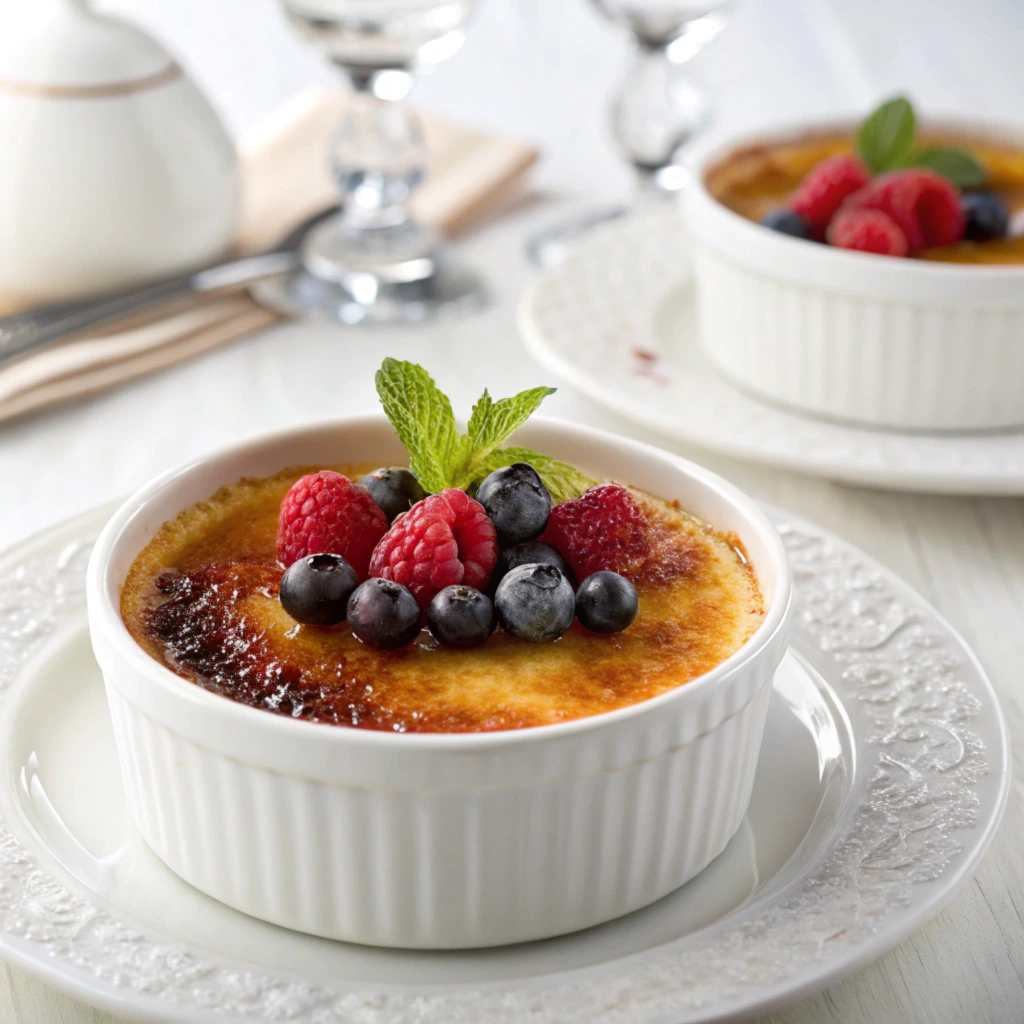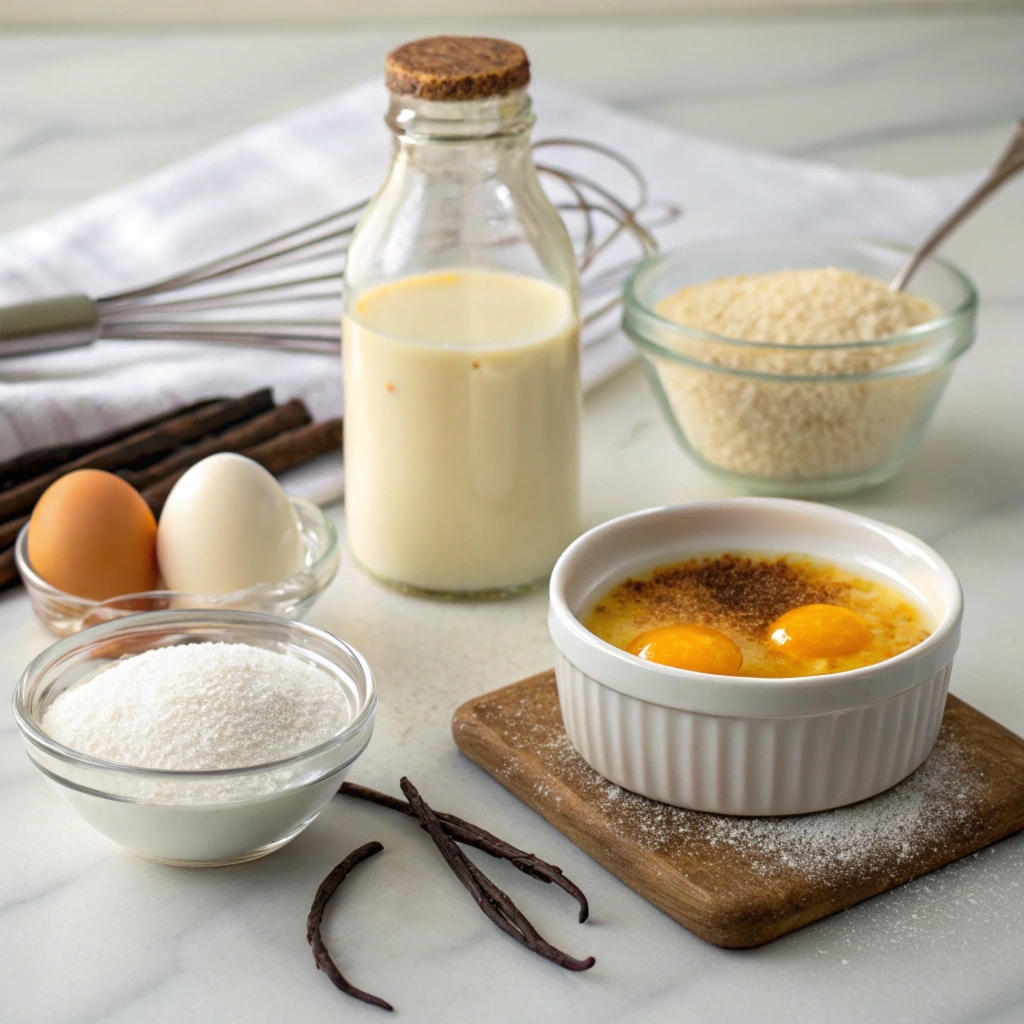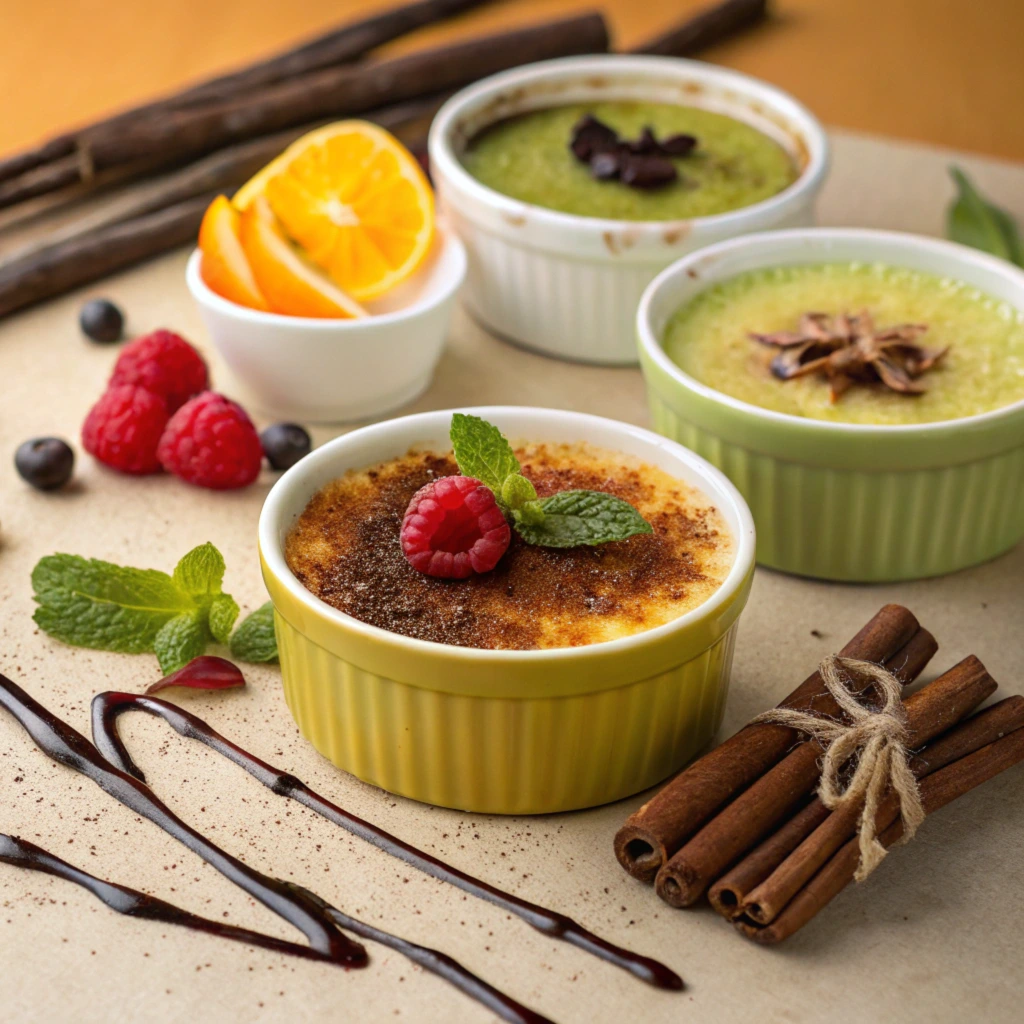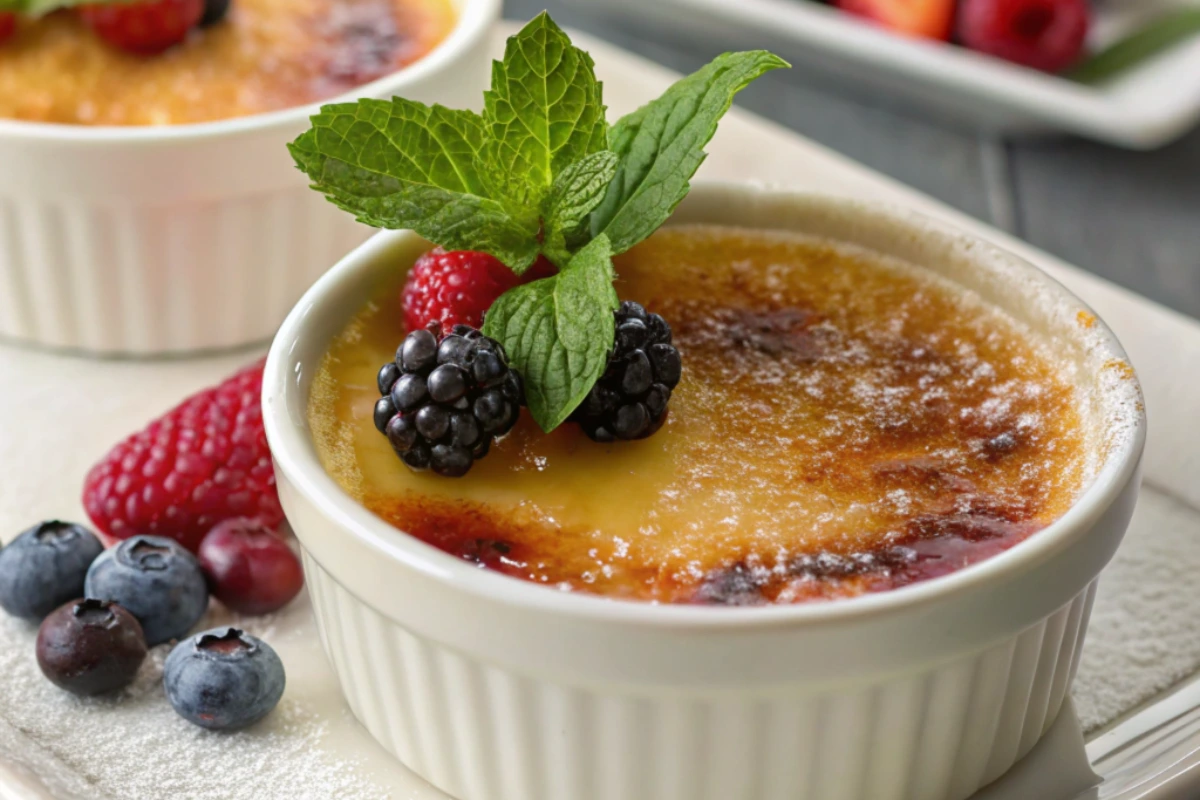Crème brûlée, a dessert synonymous with sophistication and indulgence, is a crowd-pleaser that boasts a rich, creamy texture topped with a crisp caramelized sugar crust. In this article, we’ll dive into what makes this classic dessert so extraordinary, unravel its key ingredients, explore the science behind its silky consistency, and even offer tips for perfecting it at home. Whether you’re a budding baker or a dessert aficionado, this guide will provide everything you need to appreciate this timeless treat.

Introduction to Crème Brûlée
What is Crème Brûlée?
At its core, crème brûlée is a custard dessert made with simple yet essential ingredients like heavy cream, sugar, and egg yolks. The name itself, which translates to “burnt cream” in French, refers to its distinctive caramelized sugar topping. This dessert is all about balance, pairing the rich, creamy base with a brittle, sweet crust.
A Brief History of Crème Brûlée
Did you know crème brûlée’s origins trace back to 17th-century France? While its exact beginnings are a bit murky, many credit chef François Massialot with popularizing it in his 1691 cookbook. Over the centuries, it has evolved but retained its reputation as a luxury dessert served in high-end restaurants worldwide.
Why is it Popular Worldwide?
The appeal of crème brûlée lies in its universal simplicity and elegance. Its creamy custard base offers a comforting texture, while the caramelized top adds a delightful crunch. Plus, its adaptability whether infused with vanilla, coffee, or fruit flavors makes it a versatile choice for any occasion.
The Key Ingredients of Crème Brûlée
Heavy Cream: The Foundation of the Custard
At the heart of crème brûlée lies heavy cream, the ingredient that gives the dessert its velvety, melt-in-your-mouth texture. This thick and rich dairy product serves as the base for the custard. Using high-quality heavy cream is crucial because it contributes to the dessert’s luxurious consistency. Substituting it with lighter creams or milk will yield a less satisfying texture, so it’s worth investing in the best you can find.
Egg Yolks: The Secret to Richness
Egg yolks are the unsung heroes of crème brûlée, providing the custard with its signature creamy structure. They not only thicken the mixture but also add a layer of richness that’s hard to beat. When gently combined with the other ingredients, the egg yolks work their magic by creating a custard that’s smooth, cohesive, and deliciously indulgent.
Sugar: Sweetness and Caramelization
Sugar plays a dual role in crème brûlée. First, it sweetens the custard, ensuring every bite is perfectly balanced. Then, it transforms into the caramelized sugar crust that defines this dessert. By sprinkling granulated sugar over the custard and caramelizing it, you get a satisfying crunch that contrasts beautifully with the creamy base.
Vanilla Extract: Enhancing Flavors
Vanilla extract is the crème brûlée’s flavor backbone. Its subtle, warm notes complement the richness of the custard without overpowering it. For an elevated touch, some bakers even use vanilla beans instead of extract, scraping the tiny seeds into the cream for a more intense and aromatic flavor.
Optional Additions: Creative Variations
Though traditional crème brûlée is flavored with vanilla, there’s room for experimentation. Many chefs infuse the cream with coffee, citrus zest, or even liqueurs to put a unique spin on the classic. Some opt to layer the custard with fruits or chocolate to create stunning flavor contrasts.

The Science Behind Crème Brûlée’s Texture
How Ingredients Interact to Form Custard
Crème brûlée’s silky consistency is no accident, it’s a result of the perfect harmony between its ingredients. The proteins in egg yolks, when heated gently, coagulate to create a custard that’s smooth yet firm. Meanwhile, the heavy cream adds richness, ensuring the texture stays soft and luscious.
The Role of Fat Content in Heavy Cream
Fat content plays a vital role in achieving the dessert’s trademark creaminess. The higher the fat percentage in your heavy cream, the more decadent your custard will feel. This is why using full-fat cream is non-negotiable when aiming for the authentic crème brûlée experience.
Achieving the Perfect Set with Egg Yolks
Egg yolks are sensitive to temperature, which makes the cooking process critical. Overheat them, and your custard could curdle; undercook, and it won’t set properly. A low, steady baking temperature and a water bath help control the heat, ensuring a custard that’s perfectly smooth and just firm enough to hold its shape.
Mastering the Caramelized Sugar Topping
Techniques for Even Caramelization
The caramelized sugar crust is the pièce de résistance of crème brûlée. To achieve an even layer, sprinkle granulated sugar lightly across the top of the custard. Avoid piling it on, as too much sugar can result in a burnt and uneven crust. For best results, hold the torch about 2-3 inches from the surface and move it in a circular motion, ensuring the sugar melts evenly.
Using a Kitchen Torch vs. Oven Broiler
A kitchen torch is the gold standard for caramelizing sugar on crème brûlée. It allows for precision and control, helping you create the signature golden-brown crust without overheating the custard below. However, if a torch isn’t available, an oven broiler works in a pinch, just keep a close eye to prevent burning.
Tips to Avoid Burning the Sugar
Caramelizing sugar can be tricky. For a foolproof crust, use white granulated sugar instead of raw or brown sugar, which can burn more quickly. Be patient, and don’t hold the torch too close to the sugar. After caramelizing, allow the topping to cool for a minute or two before serving, it’ll harden into the perfect crunch.
For more insights into perfecting crème brûlée, check out this detailed guide on the secrets of crème brûlée.
Variations and Innovations in Crème Brûlée
Flavor Infusions: Coffee, Fruit, and Spices
While the classic vanilla version of crème brûlée is timeless, experimenting with flavors can be a delightful twist. Coffee-infused custard delivers a bold and aromatic experience, while fruit like raspberry or citrus zest adds a refreshing tang. For those who love warm spices, a touch of cinnamon or cardamom can transform this dessert into a cozy treat.

Creative Garnishes: From Fruit to Chocolate
Elevate your crème brûlée presentation with thoughtful garnishes. Fresh berries, edible flowers, or a drizzle of chocolate sauce can add visual appeal and complementary flavors. Some chefs also sprinkle a pinch of sea salt over the caramelized sugar for a sophisticated contrast.
Regional Twists and Their Origins
Around the world, chefs have adapted crème brûlée to include local ingredients. In Italy, you might find a limoncello-infused version, while in Japan, matcha green tea adds an earthy, vibrant hue. Each twist maintains the custard’s creamy base while showcasing unique flavors.
If you’re inspired by these ideas, don’t miss this comparison of crème brûlée and custard desserts.
Tips for Making the Perfect Crème Brûlée at Home
The Importance of Ingredient Quality
When it comes to making crème brûlée, ingredient quality can make or break your dessert. Always opt for fresh, high-fat heavy cream it’s the foundation of the custard’s rich texture. Similarly, using fresh eggs ensures a silky consistency. For vanilla, consider scraping seeds from a real vanilla bean for a more pronounced flavor compared to extract.
Temperature and Baking Time Best Practices
One of the secrets to perfect crème brûlée lies in how you bake it. A low, consistent temperature typically around 320°F is essential to prevent overcooking. Additionally, using a water bath helps maintain even heat, which prevents the custard from curdling or cracking. Bake until the edges are set but the center still jiggles slightly when shaken.
Using a Water Bath for Even Cooking
A water bath might seem like an extra step, but it’s crucial for getting that smooth custard texture. To prepare, place the ramekins in a deep baking dish, then pour hot water around them until it reaches halfway up the sides. This gentle cooking method ensures the custard heats evenly, avoiding those dreaded lumps.
For more helpful baking tips, explore this guide on the best cream for crème brûlée.
Serving Suggestions and Pairings
Choosing the Right Beverage: Coffee or Dessert Wine
Pairing your crème brûlée with the perfect beverage takes its enjoyment to a whole new level. A rich, dark roast coffee, with its bold and slightly bitter profile, provides an excellent counterpoint to the dessert’s sweetness. The strong flavors of the coffee cut through the richness of the custard, balancing the overall taste and leaving a pleasant finish.
For wine lovers, sweet dessert wines such as Sauternes or Muscat offer an equally delightful pairing. These wines boast notes of honey, apricot, and citrus that beautifully echo the caramelized sugar crust’s toasty flavors. The wine’s sweetness enhances the custard’s creamy profile, creating a symphony of tastes in every bite and sip. If you prefer a lighter option, sparkling wines like Prosecco or Moscato d’Asti can add a refreshing, effervescent touch to the experience.
Beyond coffee and wine, other drinks can complement crème brûlée. Herbal teas, such as chamomile or mint, offer a soothing and aromatic accompaniment, while hot chocolate provides a decadent pairing for those with an extra sweet tooth.
How to Plate Crème Brûlée Elegantly
Presentation is an important part of making crème brûlée feel special. To begin with, use classic ramekins for a traditional and timeless style. Moreover, the smooth, golden top of the caramelized sugar already looks elegant, but adding small garnishes can make it even more appealing.
For instance, fresh berries like raspberries or blackberries add bright color and a tart flavor that pairs well with the sweet custard. Additionally, a sprig of fresh mint gives a pleasant scent and a refreshing touch. For a modern twist, you could drizzle a little chocolate or caramel sauce on the plate next to the ramekin, making the dish even more inviting.
Furthermore, you can try other creative serving ideas. For example, pairing crème brûlée with whipped cream or edible flowers can make it look even more stunning. If you’re hosting a dinner party, consider serving each portion on a decorative plate with matching garnishes to bring everything together and create a cohesive presentation.
For more ideas on plating and recipes, check out this article on crème brûlée innovations.
FAQs About Crème Brûlée
Can I Make Crème Brûlée Without a Torch?
Absolutely! While a kitchen torch is the most convenient tool for caramelizing the sugar topping, you can use your oven’s broiler as an alternative. Simply place the ramekins under the broiler on the highest setting and watch closely as the sugar melts and browns. Be careful not to overdo it, as the broiler can burn the sugar quickly.
What Are the Best Substitutes for Heavy Cream?
If you’re out of heavy cream or looking for a lighter alternative, you can use half-and-half or a mix of whole milk and butter. However, keep in mind that substitutes with less fat will result in a thinner and less rich custard. For the best results, stick to full-fat cream to preserve the dessert’s signature texture.
How Do I Fix Overcooked or Undercooked Custard?
If your crème brûlée custard is overcooked, it may develop an unpleasant, grainy texture. Unfortunately, this cannot be reversed, so careful baking is key. For undercooked custard, return the ramekins to a water bath and bake gently at a low temperature until the center sets. Always monitor closely to avoid errors.
Conclusion
Why Crème Brûlée Remains a Timeless Dessert
Crème brûlée’s charm lies in its simplicity and sophistication. With just a handful of ingredients, heavy cream, egg yolks, sugar, and vanilla. It transforms into a luscious dessert that’s hard to resist. The contrast between its creamy custard base and crisp caramelized topping creates an experience that delights the senses.
Whether you’re savoring the classic version or experimenting with bold flavors, crème brûlée is a dessert that continues to captivate dessert lovers worldwide. Its enduring popularity is a testament to the magic of its simple yet exquisite composition. Try making it at home, and you might just discover your new favorite sweet treat!
A Classic That Appeals Across Cultures
Though its roots are firmly planted in French culinary tradition, crème brûlée has crossed borders and won hearts around the world. Its simplicity allows for endless variations, making it a favorite in both traditional and modern kitchens. From vanilla-infused custard in fine dining restaurants to creative twists in home kitchens, crème brûlée’s adaptability keeps it relevant across cultures and generations.

